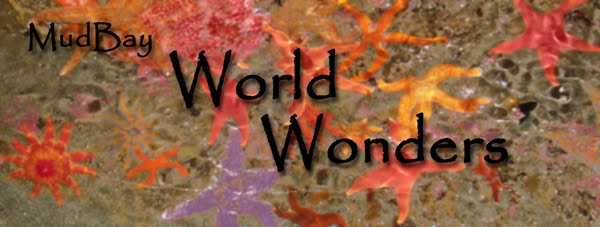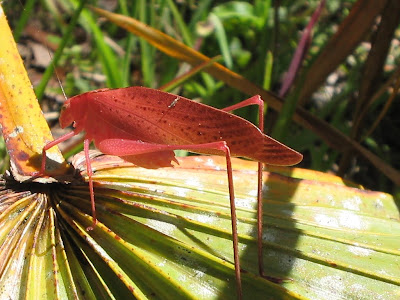For a video of these amazing creatures, click here.
Thursday, April 29, 2010
Sea Dragons
For a video of these amazing creatures, click here.
Tuesday, April 27, 2010
Seeing Pink
From Professor Dan Johnson, former President of the Entomological Society of Canada :
"Many species of Orthoptera have rare colour forms that are typically rose or pink in colour. It is often found in the Acrididae and Tettigoniidae. The rose form of some grasshoppers appears to be genetic. The rose colour is not restricted to one species of family of grasshoppers and katydids, but is is always rare. In some cases, the proportion of rose-coloured members of a local population may increase to as much as 10%, but typically they are rare, on the order of 1 per 1000 to 1 per 10,000, or even rarer.
The Buggy Facts:
The family Tettigoniidae, known in American English as katydids and in British English as bush-crickets, contains more than 6,400 species. It is part of the suborder Ensifera and the only family in the superfamily Tettigonioidea. They are also known as long-horned grasshoppers, although they are more closely related to crickets than to grasshoppers.
Many tettigoniids exhibit mimicry and camouflage, commonly with shapes and colors similar to leaves.
Tettigoniids may be distinguished from grasshoppers by the length of their filamentous antennae, which may exceed their own body length, while grasshoppers' antennae are always relatively short and thickened.
The males of tettigoniids have sound-producing organs (via stridulation) located on the hind angles of their front wings. In some species females are also capable of stridulation.
There are about 255 species in North America, but the majority of species live in the tropical regions of the world.
World's Smallest Horse

(info and photos by Associated Press)

For full article and the owners' YouTube video link (seeing him scamper will put a smile in your heart), click here.
Monday, April 26, 2010
Cave of Giant Crystals
Have you ever thought about what it would be like to miniaturize yourself and climb right into the middle of (or even live inside of) a geode? I used to daydream about such things as a child, while holding one of these fascinating, crystal-laden rocks in my hands. Sometimes, dreams do come true:
Ten years ago while excavating a tunnel, two miners discovered a giant crystal cave more than 1,000 feet below the town of Naica, Mexico. The cave contains translucent selenite gypsum crystal beams measuring up to 36 feet long and weighing up to 55 tons. The crystals thrived because they were submerged in mineral-rich water with a very narrow, stable temperature range of approximately 136 degrees Farenheit.
Volcanic activity that began about 26 million years ago created Naica mountain and filled it with high-temperature anhydrite, which is the anhydrous—lacking water—form of gypsum. Anhydrite is stable above 136 degrees Fahrenheit. Below that temperature, gypsum is the stable form.
When magma underneath the mountain cooled and the temperature dropped below 58 degrees Celsius, the anhydrite began to dissolve. The anhydrite slowly enriched the waters with sulfate and calcium molecules, which for millions of years have been deposited in the caves in the form of huge selenite gypsum crystals. For the Cave of Crystals to have grown such gigantic crystals, it must have been kept just below the anhydrite-gypsum transition temperature for many hundreds of thousands of years.
Interesting Facts:
- The giant crystals found in the caves at Naica are softer than a human fingernail.
- The largest crystal found at Naica is 500,000 years old.
- The stunning crystal pillars are made from the same common mineral as drywall – it's called gypsum.
- The Naica cave's deadly heat comes from the depths of the Earth. Naica sits on a set of fault lines. A magma chamber a mile and a half down warms the water that flows throughout the mountain.
- The Naica principle cave "Cueva de Los Cristales" is 113 degrees Farenheit and 100% humidity.
For more information about the efforts being made to study and preserve this incredible natural wonder, visit National Geographic's website. (For video clip, click here.)

















